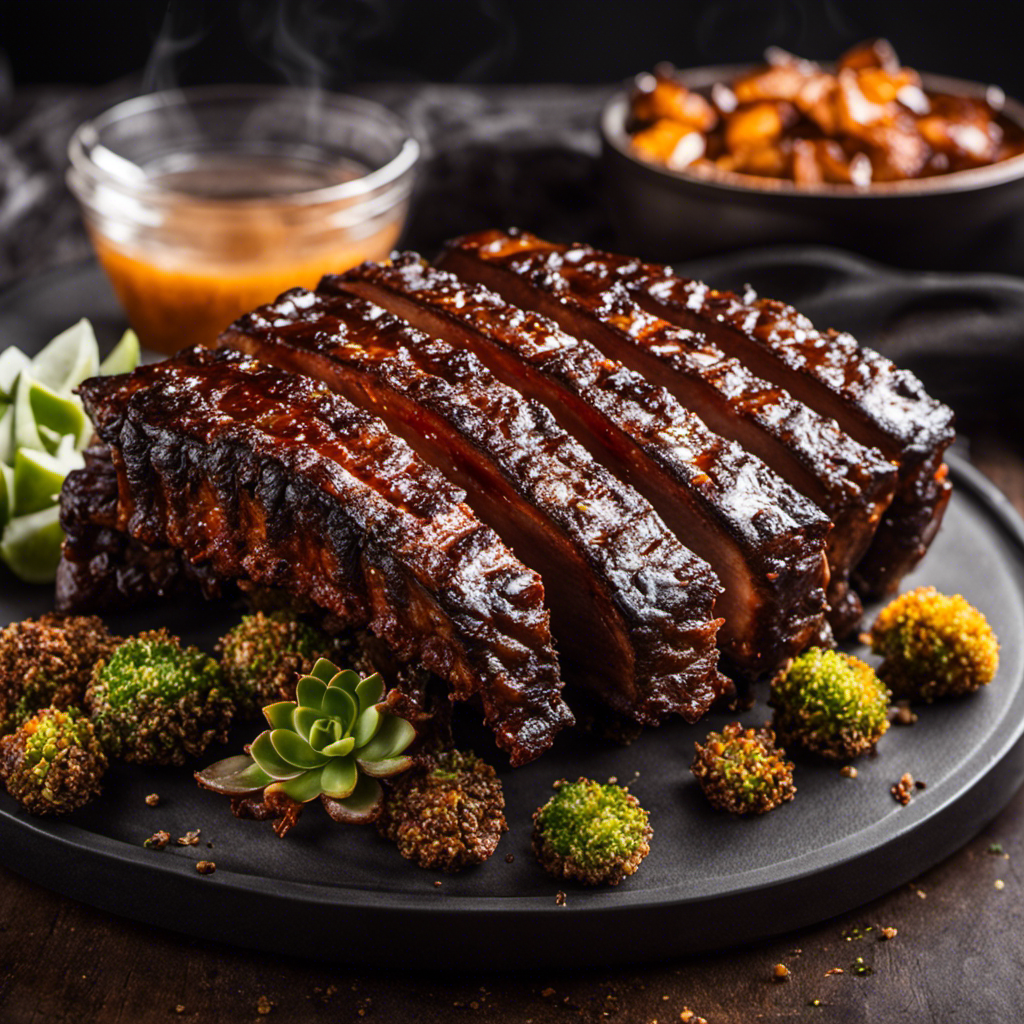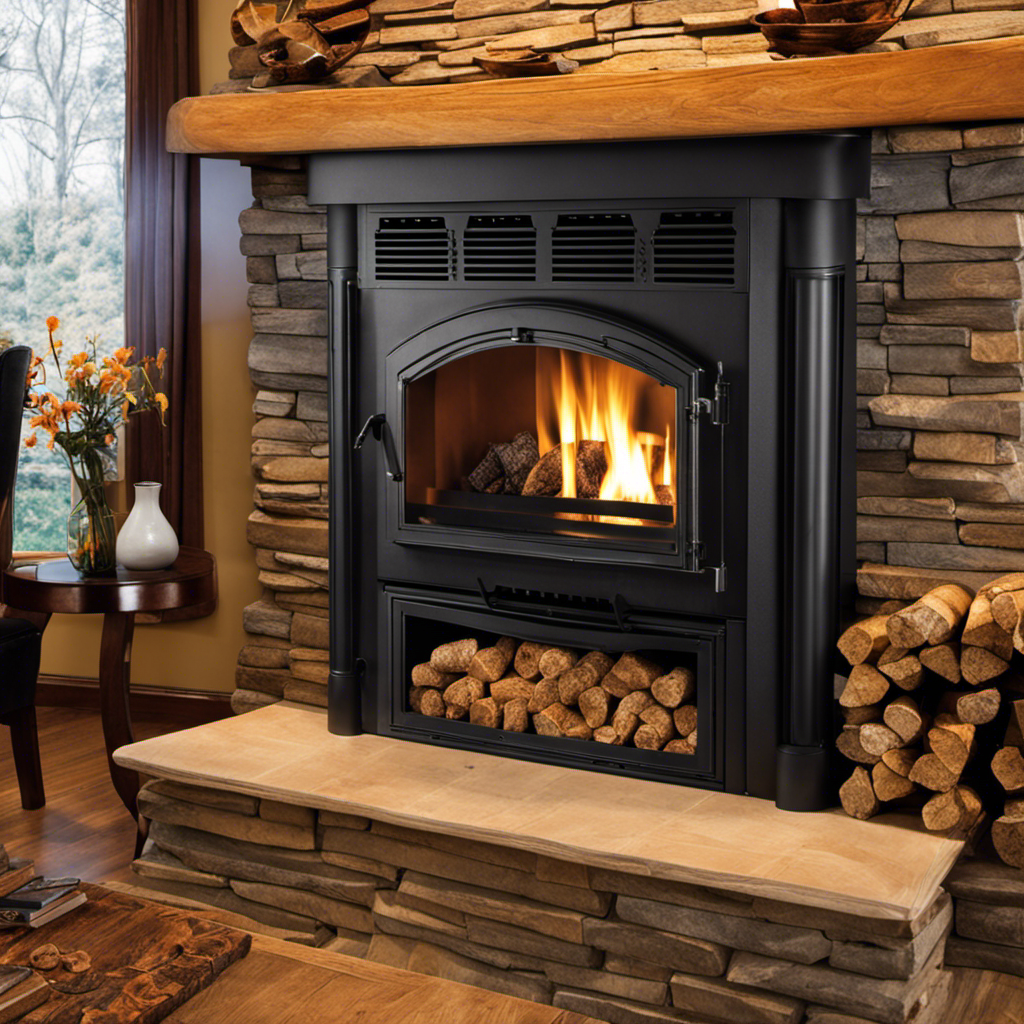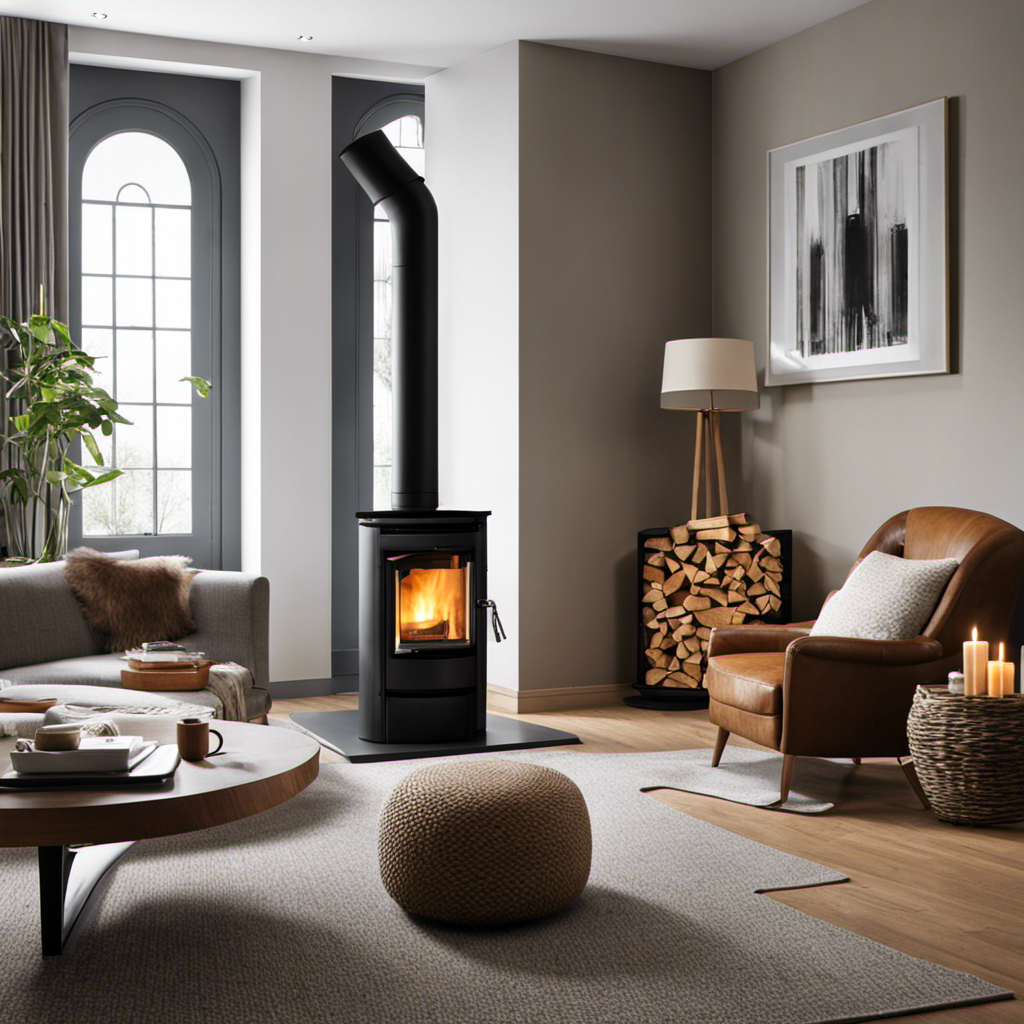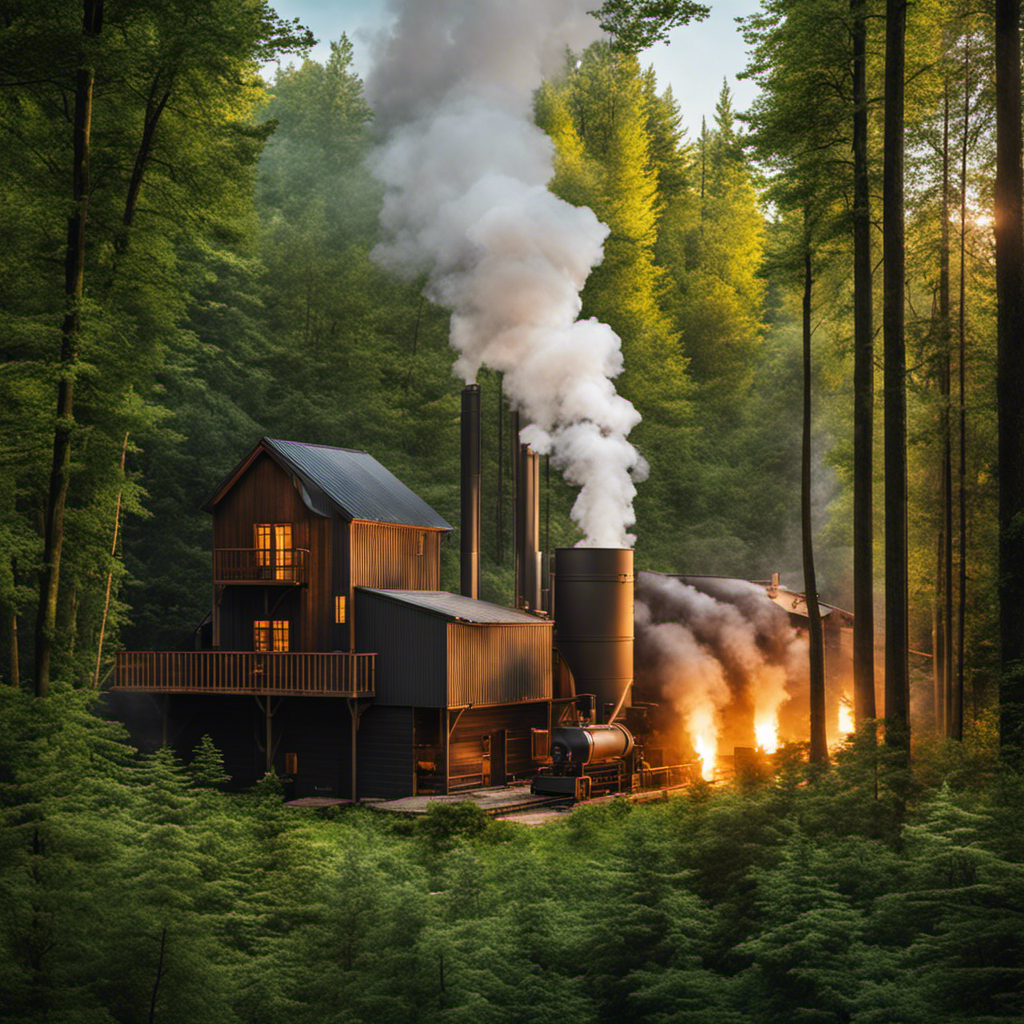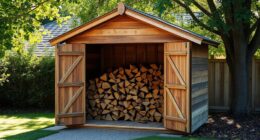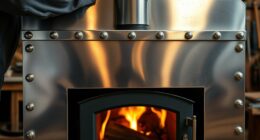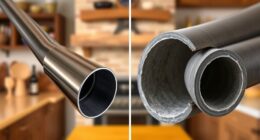I’ve always been captivated by the irresistible, deep taste of ribs cooked to perfection. Now, with the reliable Traeger Wood Pellet Grill at my disposal, I can effortlessly recreate that delectable flavor right in my own backyard.
In this article, I’ll share my knowledge and experience on how long it takes to smoke ribs using a Traeger. From understanding the grill to choosing the right wood pellets, preparing the ribs, and monitoring the smoking process, we’ll cover it all.
Get ready for some deliciously tender and flavorful ribs from your Traeger grill!
Key Takeaways
- Preheating the Traeger grill to 225°F is recommended for smoking ribs
- Different wood pellets impart unique flavors, with hickory being recommended for smoking ribs
- Maintaining a consistent smoking temperature is crucial for tender and flavorful ribs
- Proper seasoning techniques, such as using dry rubs or marinades, enhance the flavor of the ribs
Understanding the Traeger Wood Pellet Grill
The Traeger Wood Pellet Grill is a versatile cooking appliance that’s perfect for smoking ribs and other meats. It uses wood pellets as fuel, which adds a unique smoky flavor to your dishes.
To get the most out of your Traeger grill, it’s important to understand how it works and how to troubleshoot common issues. One common problem is uneven heating, which can be resolved by ensuring the grill is clean and the heat deflector is properly positioned.
Another issue is temperature fluctuations, which can be caused by a dirty temperature probe or a faulty controller. By regularly cleaning and maintaining your Traeger grill, you can ensure consistent and delicious results every time you use it.
Now, let’s dive into getting started with smoking ribs on a Traeger.
Getting Started With Smoking Ribs on a Traeger
To get started smoking ribs on a Traeger grill, you’ll want to ensure you have all the necessary supplies and ingredients. Here is a helpful checklist to make sure you have everything you need:
| Supplies | Ingredients |
|---|---|
| Traeger grill | Rack of ribs |
| Wood pellets | Dry rub or marinade |
| Meat thermometer | Barbecue sauce |
| Aluminum foil |
Now that you have everything ready, it’s time to start smoking those ribs! Preheat your Traeger grill to 225°F and place the ribs directly on the grill grates. Close the lid and let the magic happen. The key to getting the perfect smoke ring is maintaining a consistent temperature and using the right wood pellets. Troubleshooting common issues such as fluctuating temperatures or excessive smoke can be resolved by adjusting the temperature settings or checking for any pellet blockages. Once you’ve mastered the art of smoking ribs on a Traeger, you can move on to choosing the right wood pellets for even more flavorful results.
Choosing the Right Wood Pellets for Smoking Ribs
When it comes to smoking ribs, choosing the right wood pellets can make all the difference in flavor and tenderness. The best wood pellet for smoking ribs will depend on personal preference, but some popular options include hickory, apple, and cherry.
Each wood pellet imparts its own unique flavor profile, so it’s worth experimenting to find your favorite. Additionally, it’s important to consider the smoking temperature recommendations for ribs to ensure they cook evenly and reach the perfect level of tenderness.
Best Wood Pellet?
What’s the best wood pellet to use in a Traeger wood pellet grill for smoking ribs?
When it comes to smoking ribs on a Traeger, the choice of wood pellet is crucial in achieving the perfect flavor. While there are many options available, I highly recommend using hickory wood pellets.
Hickory delivers a bold and smoky flavor that pairs perfectly with ribs. Its strong aroma and robust taste enhance the meat, creating a truly mouthwatering experience. When using hickory pellets, it’s important to master the smoking techniques to ensure the best results. Maintaining a consistent temperature and using the right amount of smoke will help you achieve tender and flavorful ribs.
Now that we’ve covered the best wood pellet, let’s move on to exploring some delicious and flavorful rib options.
Flavorful Rib Options?
There are plenty of delicious rib options that are packed with flavor. Whether you prefer sticky sweet or spicy tangy, there is a rib rub out there to satisfy your taste buds. From baby back ribs to spare ribs, the possibilities are endless. Here are a few flavorful rib rubs that will take your barbecue game to the next level:
| Rib Cut | Rib Rub |
|---|---|
| Baby Back | Sweet and Smoky |
| Spare Ribs | Spicy Chipotle |
| St. Louis | Kansas City Style |
Each rub is carefully crafted to enhance the natural flavors of the meat and add a delicious kick. Baby back ribs are perfect for a sweet and smoky rub, while spare ribs can handle the heat of a spicy chipotle rub. St. Louis style ribs shine with a classic Kansas City style rub.
Now that you’ve chosen the perfect rib rub, it’s time to talk smoking temperature recommendations.
Smoking Temperature Recommendations?
To achieve succulent and tender ribs, it’s important to maintain a consistent smoking temperature throughout the cooking process. The smoking time and techniques can greatly influence the final outcome of your ribs.
When it comes to smoking ribs on a Traeger grill, I recommend setting the temperature to around 225°F. This low and slow approach allows the smoke to infuse into the meat slowly, resulting in a smoky flavor and tender texture.
Depending on the size and thickness of your ribs, the smoking time can vary. As a general guideline, you can expect baby back ribs to take around 4-5 hours, while spare ribs may require 5-6 hours. It’s crucial to monitor the internal temperature of the ribs using a meat thermometer to ensure they reach the desired doneness.
Now, let’s move on to preparing the ribs for smoking on a Traeger grill, which will further enhance their flavor and tenderness.
Preparing the Ribs for Smoking on a Traeger Grill
When it comes to preparing ribs for smoking on a Traeger grill, there are two key points to consider: seasoning the ribs properly and choosing the right wood.
Seasoning the ribs is crucial to infusing them with flavor and enhancing their taste. I recommend using a dry rub or marinade that complements the smoky flavors of the grill.
Additionally, choosing the right wood is essential in achieving the desired flavor profile. Different types of wood impart distinct flavors, so it’s important to select one that pairs well with the meat and seasoning.
Seasoning the Ribs Properly
For best results, make sure you properly season your ribs before smoking them on the Traeger wood pellet grill. Seasoning is a crucial step in enhancing the flavor of your ribs and achieving that delicious smoky taste.
There are various seasoning techniques you can use, such as dry rubs or marinades, depending on your personal preference. Dry rubs typically consist of a combination of spices, herbs, and salt that are applied generously to the ribs, allowing them to absorb the flavors overnight. Marinades, on the other hand, involve soaking the ribs in a mixture of liquid seasonings, like vinegar or Worcestershire sauce, for a few hours before smoking. Both methods result in tender, flavorful ribs with a smoky undertone.
Now that your ribs are properly seasoned, let’s move on to choosing the right wood for smoking.
Choosing the Right Wood
Now that you’ve properly seasoned your ribs, it’s time to focus on selecting the right type of wood for smoking. The choice of wood can greatly enhance the smoky flavor of your ribs, so it’s important to choose wisely.
Here are the best wood options for smoking ribs:
-
Mesquite: This strong and robust wood imparts a bold smoky flavor, perfect for those who prefer a more intense taste.
-
Apple: If you’re looking for a milder, slightly sweet flavor, apple wood is an excellent choice. It adds a delicate touch to your ribs.
-
Hickory: Known for its strong and hearty flavor, hickory wood is a classic option when it comes to smoking ribs. It provides a rich and savory taste.
By carefully selecting the right wood, you can enhance the flavor of your ribs to perfection.
Now, let’s move on to setting the temperature and time for smoking ribs, ensuring a tender and succulent result.
Setting the Temperature and Time for Smoking Ribs
To smoke ribs on a Traeger wood pellet grill, you’ll want to set the temperature and time according to your desired level of smokiness and tenderness.
For tender and flavorful Traeger smoked ribs, I recommend starting with a temperature of 225°F and cooking them for 3-4 hours. This low and slow method allows the smoke to penetrate the meat, creating a delicious smoky flavor while keeping the ribs moist and tender.
However, if you prefer a stronger smoke flavor, you can increase the temperature to 250°F and cook them for 2-3 hours. Just remember to wrap the ribs in foil during the last hour of cooking to help them become more tender.
Now that you know the ideal temperature and cooking time, let’s move on to monitoring the smoking process on a Traeger grill.
Monitoring the Smoking Process on a Traeger Grill
To ensure your ribs are smoking properly, you’ll want to keep an eye on the temperature gauge and check the color of the smoke coming out of the grill. Monitoring the smoking process is crucial to achieving the perfect smoky flavor and tender texture in your ribs.
Here are some techniques to help you monitor and troubleshoot common smoking issues on your Traeger grill:
-
Temperature Gauge: The temperature gauge on your grill will give you an idea of how hot the cooking chamber is. It’s important to maintain a consistent temperature throughout the smoking process.
-
Smoke Color: The color of the smoke can tell you a lot about the smoking process. Ideally, you want a thin, blue smoke. If the smoke is thick and white, it may indicate a problem with the airflow or fuel source.
-
Troubleshooting: If you’re experiencing issues with temperature control or smoke production, check for any blockages in the air vents, ensure the pellet hopper is adequately filled, and clean the grill regularly to prevent buildup.
By monitoring these factors, you can ensure that your ribs are smoking perfectly on your Traeger grill.
In the next section, we’ll explore how to add flavor with marinades and rubs for smoked ribs.
Adding Flavor With Marinades and Rubs for Smoked Ribs
When marinating or applying rubs to your smoked ribs, it’s important to let them sit for at least an hour to allow the flavors to penetrate the meat.
The choice between a marinade and a dry rub depends on personal preference. A marinade is a liquid mixture that tenderizes the meat and infuses it with flavors. On the other hand, a dry rub consists of a combination of spices and herbs that form a flavorful crust on the surface of the ribs.
Both methods can result in deliciously smoked ribs, so it’s up to you to decide which one to use. Additionally, the type of wood pellets you choose for smoking can greatly impact the flavor of your ribs. Hickory, mesquite, and applewood are popular options, each offering a unique taste profile.
Now that you’ve marinated or applied your dry rub and chosen your wood pellets, it’s time to move on to the next step: resting and slicing your smoked ribs from a Traeger grill.
Resting and Slicing Smoked Ribs From a Traeger Grill
After all the time and effort spent smoking your ribs on a Traeger grill, it’s important to let them rest before slicing into them. Resting allows the juices to redistribute, resulting in a more tender and flavorful bite. I recommend letting your ribs rest for about 10-15 minutes before diving in.
When it comes to slicing smoked ribs, there are a few techniques you can use to achieve optimal results. Here are some tips to keep in mind:
- Use a sharp knife: A sharp knife will make it easier to slice through the meat without tearing it.
- Cut between the bones: This will ensure that each slice contains a portion of meat and a bone, adding to the presentation.
- Slice against the grain: Cutting against the grain will make the meat more tender and easier to eat.
- Remove excess fat: Trimming away any excess fat will result in a cleaner and more enjoyable eating experience.
- Serve immediately: Smoked ribs are best enjoyed when served immediately after slicing.
Now that you know how to rest and slice your smoked ribs, let’s move on to some tips and tricks for perfectly smoked ribs on a Traeger grill.
Tips and Tricks for Perfectly Smoked Ribs on a Traeger
For the most flavorful and tender ribs, it’s important to monitor the temperature throughout the smoking process. When it comes to smoking ribs on a Traeger grill, there are a few tips and tricks to ensure perfect results every time.
First, consider the different flavorful rib options available, such as baby back ribs or spare ribs.
Next, let’s talk about smoking temperature recommendations. I find that setting my Traeger to a temperature of 225°F provides the best results. This low and slow cooking method allows the ribs to absorb the smoky flavors while becoming tender and juicy.
Remember to use a reliable meat thermometer to check the internal temperature of the ribs. When they reach an internal temperature of 203°F, they are ready to be taken off the grill.
With these tips, you’ll be enjoying delicious, melt-in-your-mouth ribs in no time!
Frequently Asked Questions
Can I Use Any Type of Wood Pellets in a Traeger Wood Pellet Grill?
Yes, you can use different types of wood pellets in a Traeger wood pellet grill. Each type has its own unique flavor profile, so it’s worth experimenting to find your favorite.
How Often Do I Need to Clean My Traeger Wood Pellet Grill?
I clean my Traeger wood pellet grill regularly to maintain its performance and ensure food safety. It’s important to clean the grill after every use to remove grease and food residue, and deep clean it at least once a month.
Can I Smoke Other Meats Besides Ribs on a Traeger Wood Pellet Grill?
Yes, you can smoke a variety of meats on a Traeger Wood Pellet Grill. The grill’s versatility allows for different cooking techniques and the wood pellets add unique flavor profiles to enhance the taste of any meat.
How Long Should I Let the Ribs Rest Before Slicing Them?
Resting time is crucial for tender, juicy ribs. After smoking, I let them rest for at least 10 minutes before slicing. This allows the juices to redistribute and ensures a more flavorful bite. As for slicing techniques, I recommend cutting between the bones for neat and even portions.
Can I Use a Traeger Wood Pellet Grill for Grilling and Smoking at the Same Time?
Yes, you can use a Traeger wood pellet grill for grilling and smoking at the same time. It offers a unique grilling/smoking combination that enhances the flavor of your food. To achieve the best results, use high-quality wood pellets specifically designed for smoking.
Conclusion
In conclusion, smoking ribs on a Traeger Wood Pellet Grill is a delicious and enjoyable experience. By following the steps outlined in this article, you can achieve perfectly smoked ribs every time.
One example of a successful smoking session on a Traeger is when I used cherry wood pellets to smoke my ribs. The sweet and fruity flavor infused into the meat created a mouthwatering and tender result.
With the right temperature, time, and attention to detail, you can impress your friends and family with your Traeger-smoked ribs.
Logan’s affair with adventure began in childhood. He hailed from a small town where vast forests bordered one side and endless shores stretched on the other. His days were spent exploring uncharted woods, climbing tall trees, or listening to the tales of old sailors. This early immersion in a world brimming with stories and mysteries became the foundation of his passion for writing.

